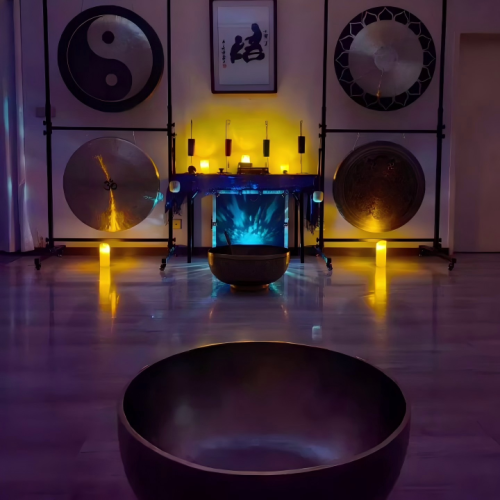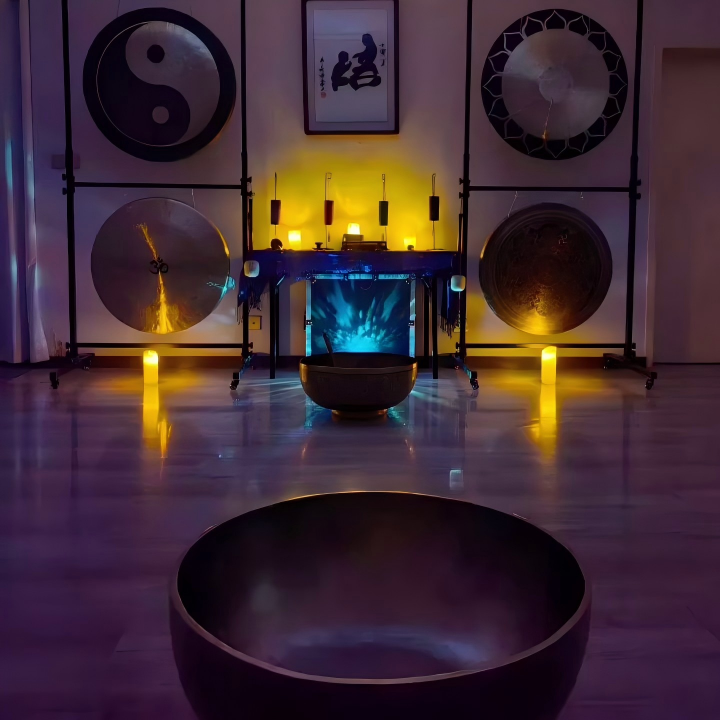

The ancient wisdom of sound healing has experienced a remarkable renaissance in our modern world, as people increasingly seek natural approaches to wellness and spiritual development. Among the most revered instruments in this acoustic healing tradition are singing bowls and gongs—two powerful tools that have served spiritual communities for millennia and continue to offer profound benefits for contemporary practitioners seeking balance, healing, and transformation.
While both instruments share common ground in their spiritual origins and therapeutic applications, they possess distinctly different acoustic characteristics and healing frequencies that make each uniquely suited to specific purposes and preferences. Understanding these differences empowers practitioners to make informed choices about which instrument best serves their individual needs, whether for personal practice, professional healing work, or community wellness activities.
The relationship between sound and healing reflects humanity’s ancient understanding that everything in existence vibrates at specific frequencies, and that these vibrations can influence our physical, emotional, mental, and spiritual states. Both singing bowls and gongs harness this vibrational power, yet they do so through markedly different acoustic signatures that create unique pathways to wellness and consciousness expansion.
This exploration of their distinctive characteristics will illuminate how each instrument’s specific frequency patterns, harmonic structures, and acoustic properties contribute to their therapeutic effectiveness while helping practitioners understand when and how to use each tool most appropriately for optimal healing outcomes.

Singing bowls trace their origins to the Himalayan regions, where they emerged from centuries-old metallurgical traditions in Tibet, Nepal, Bhutan, and northern India. These sacred instruments developed within Buddhist monastic communities as tools for meditation, ceremony, and spiritual practice, carrying forward ancient wisdom about sound’s capacity to facilitate consciousness transformation and inner peace.
The traditional crafting process involves creating seven-metal alloys that correspond to celestial bodies and their associated energetic qualities, with master craftspeople passing down techniques through generations of apprenticeship and spiritual dedication. These traditional bowls were forged by hand using methods that required deep understanding of metallurgy, acoustics, and spiritual principles that governed their creation and use.
Buddhist monasteries integrated singing bowls into daily practices including meditation sessions, ceremonial rituals, and community gatherings, recognizing their capacity to create acoustic environments conducive to contemplative states and spiritual awakening. The bowls’ gentle, sustained tones provided ideal focal points for concentration development while supporting the peaceful atmosphere necessary for sustained spiritual practice.
The introduction of singing bowls to Western cultures during the 20th century coincided with growing interest in Eastern spirituality and alternative healing approaches, leading to widespread adoption in meditation centers, wellness practices, and therapeutic applications that honor their traditional spiritual functions while adapting them to contemporary healing needs.
Singing bowls possess a distinctive bowl-shaped metal construction with carefully engineered wall thickness variations that determine their acoustic characteristics and tonal qualities. The diameter, depth, and rim design all contribute to the instrument’s frequency response and harmonic complexity, with traditional proportions based on mathematical relationships that optimize both acoustic performance and spiritual effectiveness.
The traditional seven-metal alloy composition includes gold, silver, mercury, copper, iron, tin, and lead, each contributing specific acoustic and energetic qualities to the bowl’s overall character. Modern bowls often use bronze alloys or other metal combinations that provide excellent acoustic properties while meeting contemporary safety and availability requirements.
Sound production occurs through friction or striking techniques that cause the bowl’s walls to vibrate in complex patterns, creating fundamental frequencies accompanied by rich harmonic series that give singing bowls their characteristic warm, sustained tones. The interaction between the playing tool and bowl rim determines the specific acoustic output, allowing for dynamic control over volume, tone quality, and harmonic emphasis.
The bowl’s resonant cavity acts as an acoustic amplifier that shapes and projects the sound, while the metal’s density and composition influence sustain duration and harmonic complexity. These physical characteristics combine to create instruments capable of producing clear, penetrating tones that can sustain for extended periods while maintaining harmonic richness and tonal clarity.
Basic singing bowl technique involves either striking the bowl with a mallet to produce bell-like tones or using circular friction around the rim to create sustained singing sounds. The striking technique produces immediate acoustic impact with clear attack characteristics, while the friction method generates continuous tones that can be maintained indefinitely with proper technique and concentration.
Advanced playing approaches include varying pressure, speed, and angle to control tone quality, volume, and harmonic emphasis, allowing skilled practitioners to create subtle acoustic variations that support different therapeutic or meditative objectives. The ability to gradually build intensity or create gentle fade-outs provides powerful tools for guiding consciousness states and facilitating healing processes.
Multiple bowl arrangements enable practitioners to create complex harmonic environments using bowls of different sizes and pitches, arranged to produce complementary frequencies that support specific therapeutic goals or consciousness states. These multi-bowl setups can create acoustic mandalas that surround listeners with carefully orchestrated sound fields designed to facilitate deep relaxation and spiritual experience.
Environmental factors including room acoustics, temperature, humidity, and background noise significantly influence singing bowl effectiveness, requiring practitioners to understand how these variables affect acoustic performance and adjust their technique accordingly to maintain optimal therapeutic conditions for different settings and applications.

Gongs originated in ancient Asian civilizations during the Bronze Age, developing from sophisticated metallurgical traditions that created large, resonant metal discs capable of producing powerful, penetrating sounds for ceremonial, spiritual, and practical applications. Archaeological evidence suggests that gongs appeared earliest in regions that would become China, Southeast Asia, and the Indonesian archipelago.
Religious traditions across Asia adopted gongs for diverse spiritual purposes including temple ceremonies, monastic schedules, meditation support, and consciousness transformation practices. Buddhist monasteries used gongs to mark meditation periods and coordinate community activities, while Taoist practices integrated them into energy cultivation and internal alchemy work that required precise timing and acoustic support.
The gamelan orchestras of Indonesia developed perhaps the most sophisticated gong applications, creating complex musical systems that used multiple gongs of varying sizes and pitches to produce intricate acoustic environments for ceremonial, artistic, and spiritual purposes. These traditions demonstrated the gong’s capacity to serve both musical and therapeutic functions within unified cultural frameworks.
Western adoption of gongs for healing and consciousness work emerged during the 20th century as practitioners recognized their powerful capacity to facilitate deep relaxation, emotional release, and transformational experiences that complemented established therapeutic and spiritual practices while offering unique benefits not available through other acoustic tools.
Gong construction involves creating large, circular metal plates with specific thickness variations and surface treatments that enable complex vibrational patterns when activated through percussion. The central boss or raised area common in many gong designs serves as a primary resonance point that influences the instrument’s fundamental frequency and harmonic development, while the outer rim areas contribute additional harmonic components and sustained resonance.
Size variations in gongs create dramatically different acoustic characteristics, with smaller instruments producing higher fundamental frequencies and faster attack and decay times, while larger gongs generate lower frequencies with extended sustain periods and more complex harmonic evolution. This size-based acoustic diversity enables practitioners to select instruments that match specific therapeutic objectives or aesthetic preferences.
The metallurgical composition of gongs typically involves bronze alloys optimized for maximum resonance and harmonic complexity, with traditional formulations refined over centuries to achieve optimal acoustic properties. The aging and seasoning process that occurs over time can significantly improve a gong’s acoustic characteristics, with older instruments often developing more complex and pleasing harmonic structures.
Vibrational patterns in gongs involve complex interactions between multiple resonance modes that create their characteristic rich, evolving soundscapes. These multiple resonance modes produce the non-harmonic frequency components that give gongs their distinctive metallic timbre and their capacity for creating acoustic environments that can facilitate altered states of consciousness and deep therapeutic experiences.
Basic gong technique involves learning appropriate mallet selection, striking locations, and timing approaches that can access the full range of acoustic possibilities within each instrument. Soft mallets produce gentler attacks with emphasis on sustained resonance and harmonic development, while harder mallets create more dramatic initial impacts that can trigger powerful acoustic events suitable for therapeutic breakthrough moments or ceremonial climaxes.
Advanced playing techniques include roll techniques that create continuous acoustic textures, selective striking patterns that emphasize specific harmonic components, and dynamic control that shapes the acoustic experience over extended time periods. These sophisticated approaches enable players to craft complex acoustic journeys that can guide listeners through various states of consciousness and therapeutic transformation.
Multiple gong orchestration involves understanding harmonic relationships between different instruments and developing ensemble techniques that create immersive acoustic environments. These multi-gong applications can produce acoustic complexity that single instruments cannot achieve, enabling practitioners to create therapeutic experiences of extraordinary depth and transformative potential.
Contemporary gong applications have expanded to include electronic processing, extended techniques using alternative implements, and integration with other healing modalities that create hybrid approaches to sound-based intervention. These innovations demonstrate the gong’s adaptability to modern therapeutic contexts while preserving its essential acoustic characteristics and transformative potential.
Singing bowls typically operate within frequency ranges that correspond to musical pitches, with smaller bowls producing frequencies in the upper mid-range (approximately 400-800 Hz) and larger bowls extending into lower registers (approximately 100-400 Hz). This frequency distribution places most singing bowl fundamentals within ranges that are easily perceived as musical tones with clear pitch recognition and harmonic relationships.
Gongs demonstrate much wider frequency ranges that can extend from very low frequencies (below 50 Hz) in large instruments to high-frequency components (above 4000 Hz) in the harmonic spectrum of smaller gongs. This broad frequency coverage enables gongs to create acoustic experiences that engage multiple aspects of human hearing and can produce physiological effects through both audible and sub-audible frequency components.
The frequency distribution patterns differ significantly between the two instruments, with singing bowls emphasizing clearly defined fundamental frequencies and related harmonic series, while gongs produce more complex frequency spectra that include both harmonic and non-harmonic components. This difference influences how each instrument is perceived psychologically and how they can be applied therapeutically.
Human auditory perception responds differently to these frequency characteristics, with singing bowl frequencies typically perceived as musical and melodic, while gong frequencies often create more complex psychological responses that can include altered consciousness states and deep emotional releases. Understanding these perceptual differences guides appropriate instrument selection for specific therapeutic objectives.
Singing bowl harmonic structures typically follow traditional harmonic series patterns, with overtones occurring at mathematically predictable intervals above the fundamental frequency. This harmonic predictability creates acoustically stable and psychologically comfortable listening experiences that support meditation, relaxation, and contemplative practices requiring sustained attention and mental calm.
Gong harmonic content includes both traditional harmonic series components and complex non-harmonic frequency relationships that create their characteristic metallic timbre and psychological impact. The presence of non-harmonic components contributes to the gong’s capacity for creating unusual psychological effects and facilitating altered consciousness states that can support therapeutic breakthrough experiences.
The harmonic complexity levels differ substantially between instruments, with singing bowls typically producing relatively simple harmonic structures that remain stable throughout their duration, while gongs generate evolving harmonic landscapes that change continuously as different vibrational modes interact and interfere with each other over time.
Musical versus non-musical harmonic content represents a fundamental distinction between these instruments, with singing bowls generally producing harmonically consonant sounds that fit within traditional musical frameworks, while gongs often generate acoustic textures that transcend conventional musical categories and enter the realm of sound art and therapeutic acoustics.
Attack characteristics differ significantly between singing bowls and gongs, with bowls typically producing gentler onsets that allow for subtle dynamic control and gradual acoustic development, while gongs can create dramatic initial impacts that immediately capture attention and create powerful psychological effects. These different attack characteristics influence how each instrument can be used therapeutically.
Sustain phases show marked differences, with singing bowls maintaining relatively stable acoustic characteristics throughout their duration, while gongs demonstrate continuous evolution of harmonic content, amplitude, and spectral characteristics that create dynamic acoustic experiences requiring no additional player intervention to maintain interest and therapeutic effect.
Decay patterns reveal another important distinction, with singing bowls typically exhibiting gradual, predictable amplitude reduction while maintaining harmonic stability, while gongs often show complex decay patterns where different frequency components diminish at different rates, creating continuously changing acoustic textures throughout the decay process.
Overall duration capabilities vary significantly, with skilled players able to maintain singing bowl tones indefinitely through friction techniques, while gongs rely on their natural sustain characteristics that can range from several seconds in small instruments to several minutes in large, high-quality gongs. These duration differences influence appropriate applications and playing strategies.
Determining healing objectives represents the first step in choosing between singing bowls and gongs, with relaxation and stress reduction often better served by the gentle, stable frequencies of singing bowls, while deep transformation and breakthrough experiences may benefit from the more dramatic and complex acoustic characteristics of gongs. Understanding specific therapeutic goals guides appropriate instrument selection.
Sensitivity assessment involves evaluating individual responses to different acoustic intensities and complexities, with some people finding gong sounds overwhelming or anxiety-provoking, while others may find singing bowls insufficiently engaging for their therapeutic needs. Personal sensitivity patterns often become apparent through direct experience with both instrument types.
Experience level considerations include recognizing that singing bowls generally offer more accessible entry points for beginners due to their gentler acoustic characteristics and simpler playing techniques, while gongs may require more preparation and potentially professional guidance to navigate safely and effectively, particularly for individuals new to sound healing experiences.
Practical factors such as budget constraints, storage space, portability requirements, and maintenance capabilities influence instrument selection decisions. Singing bowls typically require lower initial investments and less specialized storage, while high-quality gongs represent significant financial commitments and may require dedicated acoustic spaces for optimal use.
Space requirements differ significantly between instruments, with singing bowls suitable for intimate environments and small spaces, while gongs often require larger acoustic environments to develop their full acoustic potential and may create problematic sound levels in confined spaces or shared living situations.
Acoustic environment optimization involves understanding how room characteristics affect each instrument’s sound quality and therapeutic effectiveness. Singing bowls adapt well to various acoustic environments, while gongs may require specific acoustic conditions to achieve optimal sound quality and therapeutic impact.
Privacy and noise considerations become important factors, particularly for apartment dwellers or those sharing living spaces, as gongs can produce sound levels that may disturb neighbors or family members, while singing bowls typically generate more manageable acoustic outputs that respect acoustic boundaries.
Safety factors include recognizing that both instruments can produce sound levels that may damage hearing if used improperly, with gongs presenting higher risk due to their greater acoustic output potential. Understanding safe usage practices protects both practitioners and listeners from acoustic injury while preserving the therapeutic benefits of sound healing practices.
Complementary applications involve recognizing how singing bowls and gongs can work together to create comprehensive acoustic healing experiences, with bowls providing gentle preparation and integration phases while gongs offer opportunities for deeper transformation and breakthrough experiences within the same therapeutic session.
Sequential usage patterns might involve beginning with singing bowls to establish relaxation and receptivity, followed by gong work for deeper therapeutic intervention, and concluding with singing bowls for integration and grounding. This progressive approach maximizes the benefits of both instruments while providing psychological safety and therapeutic structure.
Timing considerations include understanding when each instrument might be most appropriate within longer therapeutic processes, with singing bowls suitable for regular maintenance and stress management, while gongs might be reserved for significant life transitions, crisis intervention, or periodic intensive therapeutic work.
Progressive development planning involves recognizing that many practitioners benefit from beginning with singing bowls to develop acoustic sensitivity and basic sound healing skills before advancing to gong work, which may require greater psychological preparation and therapeutic sophistication to navigate safely and effectively.
Hearing protection measures represent essential safety considerations for both instruments, with practitioners needing to understand safe exposure levels and duration limits that prevent acoustic injury while preserving therapeutic effectiveness. Regular hearing assessments and conservative acoustic practices protect long-term auditory health while supporting sustainable sound healing practices.
Emotional response management involves preparing for potentially intense psychological reactions that can occur with both instruments but may be more dramatic with gong experiences. Having appropriate support resources and intervention strategies available ensures safe navigation of emotional releases and therapeutic breakthroughs that may arise during sound healing sessions.
Physical sensitivity considerations include recognizing that some individuals may experience physical discomfort, dizziness, or other somatic responses to intense acoustic stimulation. Understanding these potential responses and having appropriate modification strategies enables safe practice for individuals with varying sensitivity levels and health conditions.
Special population precautions involve recognizing contraindications for pregnant women, individuals with certain medical conditions, children, and elderly practitioners who may require modified approaches or professional supervision to ensure safe and beneficial sound healing experiences.
Environmental preparation involves creating optimal acoustic and psychological conditions for sound healing practice, including attention to lighting, temperature, seating comfort, and elimination of distractions that might interfere with the therapeutic process. Proper environmental preparation significantly enhances the effectiveness of both singing bowl and gong applications.
Psychological preparation methods include setting clear intentions, establishing emotional safety measures, and creating appropriate expectations that enhance receptivity while preventing disappointment or anxiety that might interfere with therapeutic outcomes. Mental preparation often determines the success of sound healing interventions.
Technical skill development involves systematic practice and study that gradually builds competency in playing techniques, timing, and therapeutic application strategies. Developing technical proficiency enables practitioners to focus on therapeutic objectives rather than struggling with basic playing skills during healing sessions.
Effect assessment methods include developing sensitivity to subjective responses, learning to recognize positive therapeutic indicators, and tracking long-term changes that demonstrate the cumulative benefits of regular sound healing practice. Systematic assessment supports continuous improvement and validates therapeutic effectiveness.
Instrument maintenance involves understanding proper cleaning, storage, and handling procedures that preserve acoustic quality and extend instrument lifespan. Both singing bowls and gongs require specific care approaches that protect their delicate acoustic properties while maintaining their therapeutic effectiveness.
Skill maintenance strategies include regular practice schedules, continuing education opportunities, and peer learning experiences that prevent skill deterioration and support ongoing development. Maintaining technical competency ensures consistent therapeutic effectiveness and supports professional development for those offering sound healing services.
Knowledge updating channels include staying current with research developments, attending workshops and training programs, and participating in sound healing communities that share information and support practitioner development. Continuous learning enhances therapeutic effectiveness and ensures ethical practice standards.
Development planning involves setting realistic short-term and long-term goals for skill development, client service, and personal growth within sound healing practice. Strategic planning supports sustainable development while preventing burnout and maintaining enthusiasm for this transformative healing modality.
Singing bowls offer distinctive benefits including gentle, accessible therapeutic approaches that suit beginning practitioners and sensitive individuals, precise frequency control that enables targeted therapeutic interventions, convenient portability that supports regular practice and travel applications, and affordable accessibility that makes sound healing available to diverse populations seeking natural wellness approaches.
Gongs provide unique therapeutic advantages including powerful breakthrough experiences that can facilitate rapid transformation, deep clearing effects that address stubborn emotional and energetic blockages, group healing capabilities that support community wellness initiatives, and profound consciousness exploration opportunities that serve advanced spiritual and therapeutic development.
The complementary relationship between these instruments enables practitioners to access the full spectrum of sound healing benefits, with each instrument serving different phases of therapeutic development and addressing various aspects of human wellness needs. Understanding their complementary functions guides strategic application for optimal therapeutic outcomes.
Beginning practitioners benefit from starting with singing bowls to develop basic sound sensitivity, learn fundamental playing techniques, establish regular practice routines, and build confidence in sound healing applications before progressing to more intensive gong work that requires greater therapeutic sophistication and safety awareness.
Intermediate practitioners often find value in incorporating both instruments into their practice, developing advanced playing techniques, exploring creative combinations, and potentially beginning to offer sound healing services to others while continuing their own therapeutic development and skill refinement.
Advanced practitioners and professional healers benefit from mastering both instruments, understanding their therapeutic applications deeply, maintaining high safety standards, and contributing to the field through teaching, research, or service that advances sound healing knowledge and accessibility for broader populations.
Scientific research continues expanding our understanding of sound healing mechanisms, therapeutic applications, and safety considerations, with growing evidence supporting traditional practices while revealing new applications and optimization strategies that enhance therapeutic effectiveness and broaden accessibility.
Application expansion includes integration with conventional healthcare, educational settings, workplace wellness programs, and community health initiatives that demonstrate sound healing’s value for addressing contemporary stress and wellness challenges while maintaining connection to traditional wisdom and practices.
Cultural preservation efforts ensure that traditional knowledge and practices remain available while supporting appropriate adaptation and innovation that serves contemporary needs without compromising the integrity and effectiveness of these ancient healing arts.
The future of sound healing with singing bowls and gongs holds tremendous promise for contributing to human wellness and consciousness development, offering natural, accessible, and effective approaches to stress reduction, personal transformation, and community healing that honor ancient wisdom while embracing contemporary understanding and applications.
Through thoughtful selection, careful practice, and respectful application, both singing bowls and gongs can serve as powerful allies in the journey toward greater health, awareness, and spiritual development, each offering unique gifts while working together to create comprehensive sound healing experiences that serve the full spectrum of human wellness needs.

